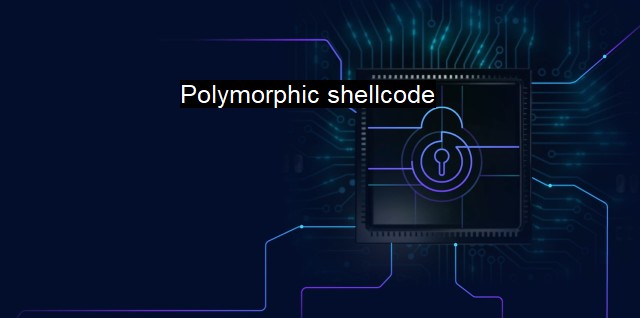What is Polymorphic shellcode?
Polymorphic shellcode represents a critical component for executing certain types of cybersecurity exploits. a shellcode typically refers to a short piece of code used as the payload in the exploitation of software vulnerability. Polymorphism, on the other hand, is a concept that refers to the ability of an object or process to take on many forms. With these understandings in place, we can proceed to outline what exactly polymorphic shellcode is, its function, its creation, and how it conflicts with anti-virus mechanisms.Polymorphic shellcode is a technique that malicious coders use to create malware that can alter its identifiable features while keeping the original functionality intact. The primary aim is to bypass security detections such as Intrusion Detection Systems (IDS) and antivirus systems, which identify malicious activities based on signatures and known patterns of malware.
When deployed, the polymorphic shellcode uses algorithms to transform itself so its underlying code appears different. Still, the functionality remains the same. A standard method used is encryption, where it typically encrypts a significant part of the shellcode. This encrypted shellcode part is followed by a decryption routine, which is responsible for decrypting the encrypted part during code execution, retracing it back to a regular shellcode.
Every instance of the polymorphic shellcode appears different to the anti-virus software or IDS as the encryption method used creates unique versions each time the code runs - the end functionality remains consistent. When embedded within an exploit code, the polymorphic shellcode modifies its decryption routine whenever execution occurs. Through this continuous mutation, the shellcode remains unrecognizable to static signature-based detection mechanisms, reducing the chance of detection significantly.
It is important to note, though, that polymorphic shellcode-generation techniques can vary in complexity and sophistication. In simple techniques, only the order of instructions changes while the overall report remains the same. More complex techniques change the entire appearance, adopting measures such as decentralized and shuffled execution order or incorporating conditional flow instructions to confuse antivirus scanners further.
Polymorphic shellcode is particularly notorious for making it challenging to write signatures to detect their presence because they have no fixed form. Antivirus programs typically operate on signatures, which essentially involves looking for identical sequences of code that have been identified as harmful in the past. polymorphic shellcodes, given their incredibly dynamic nature, pose a real challenge to this construct.
Modern antivirus systems and IDS are adjusting their approaches to deal with the polymorphic shellcodes – they use heuristic analysis, which is an analysis of the code’s behavior and not just the signature. The use of machine learning is also becoming increasingly popular to dynamically identify potential threats based on patterns and predictive analytics.
Polymorphism in the world of cybersecurity presents a significant challenge for security professionals given its elusive nature, but it also represents an area of considerable development for both security and antivirus technologies. With a constantly evolving threat landscape where attackers continue creating innovative ways to create polymorphic shellcode, the war against malware adapts too, pressing on in this everlasting cat and mouse game.
The polymorphic shellcode, while a formidable adversary in the cybersecurity battlescape, drives the continuous improvement of security systems, resiliency of infrastructure, and motivates the development of more complex and sophisticated detection mechanisms.

Polymorphic shellcode FAQs
What is polymorphic shellcode?
Polymorphic shellcode is a type of malware that constantly changes its code to evade detection by antivirus software. It is designed to be difficult for security software to identify and block, making it a popular tool for cybercriminals.How does polymorphic shellcode work?
Polymorphic shellcode works by using various techniques to transform its code, without changing its functionality. These techniques may include encryption, code obfuscation, and modifying the shellcode’s instructions. This enables the malware to bypass signature-based detection mechanisms used by antivirus software.How can organizations protect themselves against polymorphic shellcode?
Organizations can protect themselves against polymorphic shellcode by using antivirus software that includes behavioral-based detection, which can identify suspicious behavior patterns, even if the malware code is constantly changing. Additionally, implementing security best practices such as regular software updates and user training can reduce the risk of infection through social engineering tactics.Why is polymorphic shellcode considered a serious security threat?
Polymorphic shellcode is considered a serious security threat because it can easily bypass traditional antivirus defenses, making it challenging for organizations to detect and block. This type of malware can be used for various cyber attacks, including data theft, installation of additional malware, and disruption of business operations. It is essential for organizations to implement strong security measures to prevent and mitigate the impact of polymorphic shellcode attacks.| | A | | | B | | | C | | | D | | | E | | | F | | | G | | | H | | | I | | | J | | | K | | | L | | | M | |
| | N | | | O | | | P | | | Q | | | R | | | S | | | T | | | U | | | V | | | W | | | X | | | Y | | | Z | |
| | 1 | | | 2 | | | 3 | | | 4 | | | 7 | | | 8 | | |||||||